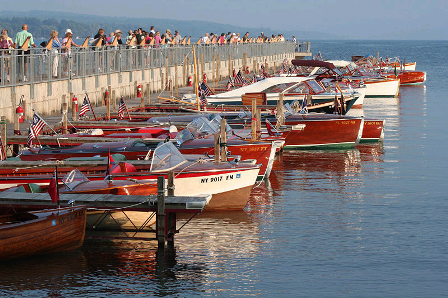 Boating in the Finger Lakes region of upstate New York is an experience people come from around the world to enjoy. Although our area’s long and narrow lakes (the seven most commonly called “Finger Lakes” are Otisco, Owasco, Canandaigua, Keuka, Seneca and Skaneateles) are usually calm and pristine, reflecting the surrounding hills like mirrors, it doesn’t mean that boating on these lakes is without risk.
Boating in the Finger Lakes region of upstate New York is an experience people come from around the world to enjoy. Although our area’s long and narrow lakes (the seven most commonly called “Finger Lakes” are Otisco, Owasco, Canandaigua, Keuka, Seneca and Skaneateles) are usually calm and pristine, reflecting the surrounding hills like mirrors, it doesn’t mean that boating on these lakes is without risk.
Boating involves serious preparation and attention to precautions. As a personal injury attorney and a avid boater myself, I thought the beginning of the summer season was a good time to remind everyone of New York state’s Boating Regulations and the New York State Navigation Law.
For more details and updates about these rules, visit the Web site of the New York State Parks and Recreation department (www.nysparks.com).
Know Your Speed Limits: To use cars as a comparison, boats don’t stop as quickly or turn as sharply. That means lake boating speed limits MUST be carefully observed for your own safety and the safety of other boaters and swimmers.
I personally keep a boat on Keuka Lake. On that lake, the boating speed limit is 45 mph during daylight, 25 mph after sunset until sunrise, and only 5 mph within 200 feet of the shore, rocks, docks, rafts or moored vessels. (The exception to the 5 mph rule is when pulling up or dropping off a water skier.)
Save Yourself, Save Others: New York state law requires that sailboats less than 23 feet long, Personal Water Craft (PWC), motor boats and manually powered vessels MUST carry the following safety equipment.
A wearable Personal Flotation Device must be available for every person on the craft. In September 2009, New York expanded its PFD rules, requiring all small boat occupants to wear life jackets during the winter as well. You can read more details about this in the NY Injury Law Blog post, “New York Makes Life Jackets Mandatory November through May.”
The PFD must be appropriate for the person wearing it – children under age 12 on boats less than 26 feet long MUST wear a correctly-sized life jacket while the boat is underway.
Boats are also required to carry throw able life preservers, to haul in anyone who needs help in an emergency.
More required equipment:
One or more fire extinguishers, depending on the size of the craft.
Every craft requires Visual Distress Signals. The form and number vary depending on the time and available light as well as the size of the craft. From sunset to sunrise, boats of 16 feet and longer are required to have red flares. During daylight, orange distress flags qualify as the required Visual Distress Signals.
Boats must have an anchor.
Boats of 39 feet long and longer must have a mechanical sound warning device, such as a horn, bell or whistle. Craft less than 39 feet may get by with a whistle, horn or by mouth – just be able to give a hearty yell of warning.
White navigation lights are a must-have as well. The bow and stern of your craft are required to be marked with white lanterns or lights to warn other boats. Sailboats require additional lighting in some circumstances. It’s best to contact the proper authorities for details.
Optional Equipment it’s Good to Have:
- First Aid Kit
- Bailer
- Boat Hook
- Paddle
- Compass
- Marine Radio
Care for Your Equipment: It’s not enough just to buy the required equipment and stow it on your boat. You’ve got to make sure it works. PLEASE BE AWARE OF EXPIRATION DATES ON FLARES AND FIRE EXTINGUISHERS
Obey the Rules of the Water: Some boating-related activities are regulated with strict rules. While water-skiing, the tow-boat must contain an observer (at least 10 years old) as well as a driver. The water-skier must be wearing an approved PFD and water-skiing is only permitted during daylight. Don’t water-ski between sunset and sunrise.
PWC, such as Jet Skis, also are restricted to use only during daylight. The drivers of such craft must be at least 14 years old, and now matter how old, must have completed – successfully – a New York state-approved safe boating course. It’s like a driver’s license – the certificate has got to be in your possession if you are asked by law enforcement to produce it.
Powerboats require training too. Youth ages 10 to 17 must have successfully completed a state-certified Power Squadron or Coast Guard Safe Boating Course in order to operate a powerboat without adult supervision. Again, the certificates for course completion must be in the operator’s possession on the boat.
A Final Word – ‘Diver Down’ Flags: All boats must stay 100 feet from “diver down” flags. Do you know how to recognize these flags? There are two:
- The Alpha Flag is a blue pennant with a white stripe at the base.
- The Diver Flag is a red rectangle with a white diagonal stripe.
Steer well clear of these flags to preserve the safety of divers. The flags could well be the only evidence of their presence below the surface.
Thanks for reading and taking an interest in boating safety. Here at the Ziff Law Firm, we have successfully handled a number of Finger Lakes boating accident cases. Check our Boating Accident Landing page for brief descriptions of some of the high-profile boating injury cases we have resolved. Many of the incidents could have been avoided entirely, by simply sticking to the rules set by New York State as well as the federal government to keep boating a safe and fun summer activity.
Thank for reading
______________________________
ZiffLaw Attorney, Esq.
NY and PA Injury and Accident Attorney
The Ziff Law Firm, LLP
303 William Street
Elmira, NY 14901
Phone: (607)733-8866
Fax: (607)732-6062
Email: info@zifflaw.com
www.zifflaw.com


